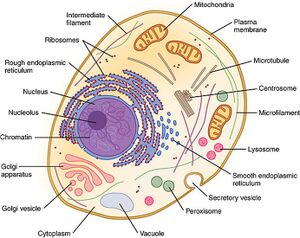Structural organization of the cell, overview of cell components
Structural Organization of the cell – overview of cell components[edit | edit source]
The cell represents the smallest structural and functional unit of an organism capable of independent existence, originating from other cells through cell division, also known as proliferation. It consists of a nucleus and cytoplasm, housing organelles enclosed by the plasma membrane. These organelles can be categorized as membranous and non-membranous.
Membranous organelles:[edit | edit source]
1. RER (Rough endoplasmic reticulum) is responsible for synthesizing proteins via polyribosomes, destined for secretion from the cytosol.
2. SER (Smooth endoplasmic reticulum) contributes to the synthesis of phospholipids and steroid hormones, detoxifies toxins, and facilitates calcium release, particularly prevalent in muscle cells where it forms the sarcoplasmic reticulum.
3. Golgi apparatus plays a pivotal role in modifying and packaging proteins synthesized in the RER.
4. Lysosomes function as sites for intracellular digestion.
5. Mitochondria are essential for aerobic respiration and ATP production.
6. Peroxisomes house enzymes crucial for lipid metabolism.
7. Nucleus, the central organelle of the cell, contains genetic material.
Non-membranous organelles:[edit | edit source]
1. Ribosomes that are not attached to any membrane, known as free-floating ribosomes, synthesize proteins for cellular use.
2. Centrosome consists of a pair of centrioles and serves as an organizing center for microtubules.
3. Cytoskeleton comprises microtubules, actin filaments, and intermediate filaments.
References[edit | edit source]
- JUNQUIERA, Anthony – MESCHER,. Junqueira's Basic Histology. 16. edition. McGraw Hill LLC, 2001. 576 pp. ISBN 1260462978.

